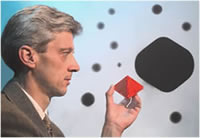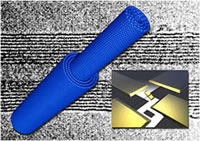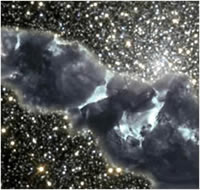| Contributions to fundamental science
made by NCEM's staff (presently 15) and users (250 a year) in the last
two decades would fill a bookshelf. They include:
|
|
 |
 |
|
|
| |
Uli Dahmen and his colleagues discovered
that nanoscale lead inclusions in an aluminum matrix assume only specific
"magic" shapes and sizes. |
|
|
- the abstruse — establishing the "critical voltage effect"
for determining submicroscopic parameters in alloys
- the practical — tracking the odd distribution of elements in
indium gallium nitride, gem of the light-emitting diode industry
- the revolutionary — discovering "magic sizes," "magic
shapes," and startling behaviors of nanoparticles in alloys, including
Brownian motion of melted inclusions in a solid matrix
-
|
|
 |
 |
|
|
|
Telescoping, multiwalled, carbon
nanotubes (electron micrograph, background) serve as cylindrical
bearings in the world's first nanomotor (inset, Zettl group).
|
|
|
the futuristic — imaging telescoping carbon nanotubes, now used
as a bearing in the world's first nanomotor.
Plus a few just-plain-intriguing mysteries:
- Uli Dahmen, Ken Westmacott, and colleagues from Case Western Reserve
University discovered that a strange "diamond-hexagonal" form
of silicon, reported by Russian investigators, formed from the intersection
of nanoscale "deformation twins." "There was hope that
a new phase of silicon would have interesting electronic properties,"
says Dahmen. "Not this one. Close but no cigar."
- Chuck Echer, who worked with many visitors during his 18 years at
NCEM, remembers being able to use "a montage of microscopy techniques
to absolutely confirm the presence of interstellar diamonds" in
carbonaceous meteorites supplied by NASA Ames Research Center.
-
|
|
 |
 |
|
|
| |
Carbonaceous meteorites and
interstellar dust contain microscopic diamonds that formed as
stars condensed. |
|
|
Echer was asked by the curator of UC's Lowie Museum of Anthropology
to date an Egyptian limestone head. Thought to be from 1600 BCE, traces
of orpiment, a paint made from a sulfur-arsenic compound, would mean
the head was more recent. "I was able to solve this dating problem
using the Analytical Electron Microscope," says Echer, who found
no orpiment. "To work on an artifact of that age was a unique forensic
investigation into the past."
Additional information
RETURN TO MAIN STORY |



